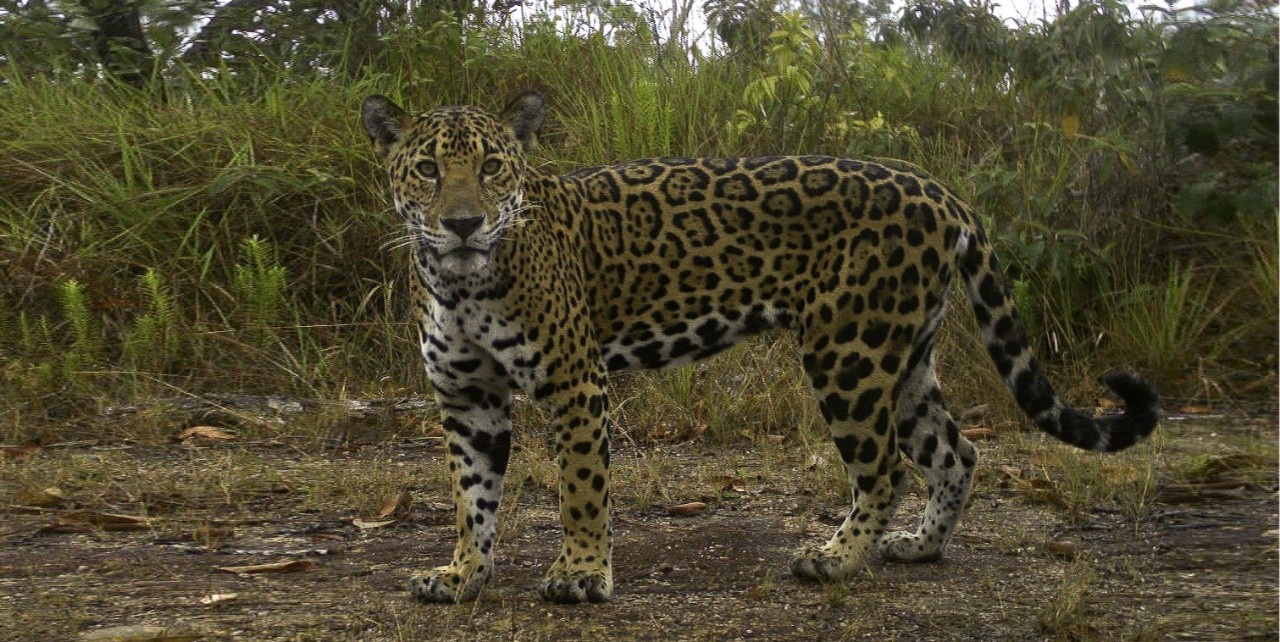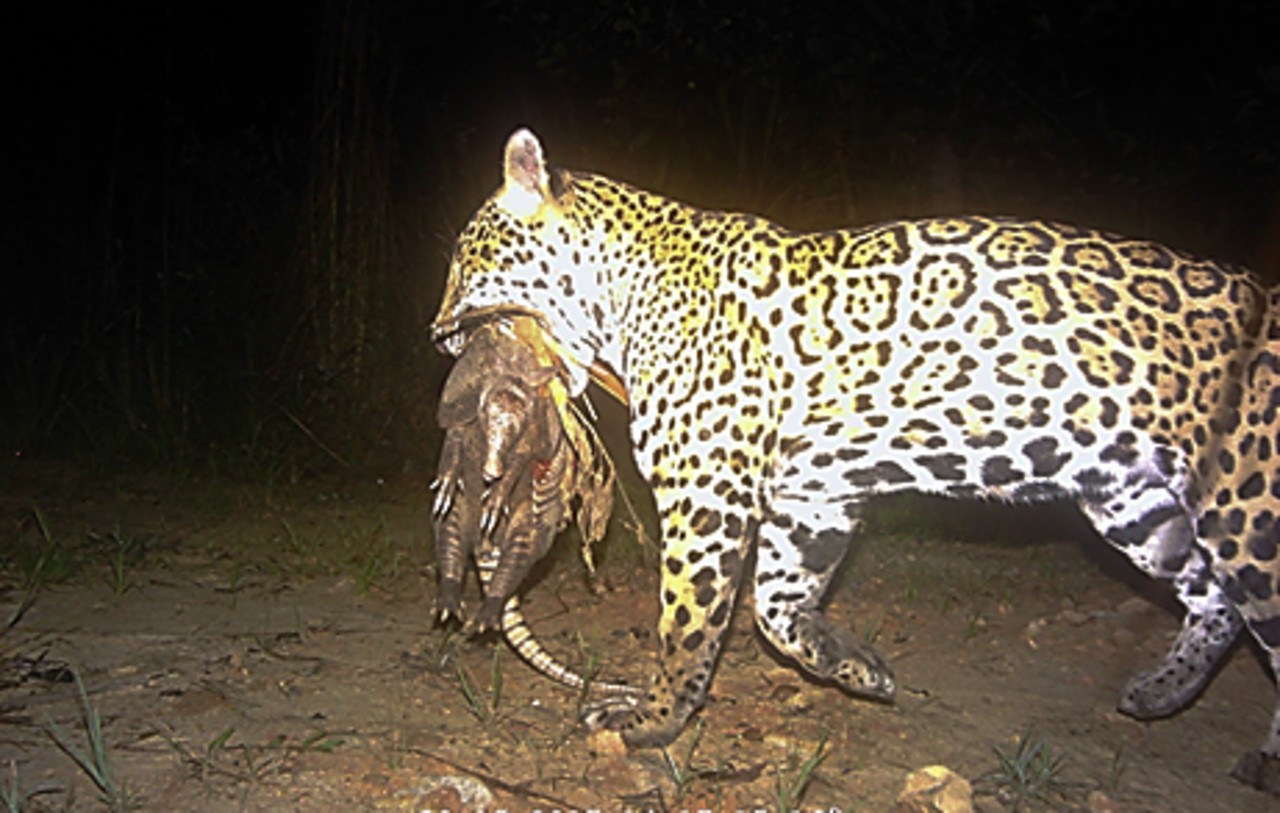
How to track animal of legend? Look to the poop
Researchers use isotopic analysis to map territories of jaguars in Belize
How do you study a predator with both camouflage and stealth that make it virtually invisible in the forest?
Even jaguars poop.
A team of researchers led by the University of Cincinnati applied isotopic analysis to jaguar scat to investigate the habitat needs of the big cats in the Mountain Pine Ridge Forest Preserve of Belize in Central America. The study demonstrates a novel and noninvasive technique for identifying the landscape use and conservation needs of elusive wildlife.

Brooke Crowley. Photo/Andrew Higley/UC Marketing + Brand
Researchers used scat-detecting dogs, named Billy and Bruiser, to find telltale evidence left behind by jaguars in the reserve, which is also home to cats such as pumas, margays, ocelots and jaguarundis. They subjected the scat to genetic analysis, known as molecular scatology, to identify not just species but also the individual cats that produced each sample. Researchers then subjected the scat to isotopic analysis, which offers clues about where the animal hunted based on the geology and vegetation of the area.
Published in the European Journal of Wildlife Research, the study concluded that the combination of genetic and isotopic analysis provides a powerful, noninvasive approach to surveying wildlife for conservation.
“We’re not interacting with the animal directly,” said Brooke Crowley, lead author and a professor of geosciences and anthropology at the University of Cincinnati. “There’s no trapping or darting. You might never see the animal, but can determine what it ate and where it ate it.”

A field crew finds jaguar tracks in the sand in Belize. Specially trained dogs help them find the scat of jaguars and other wild cats so researchers can study fecal samples. Photo/Claudia Wultsch
The Mountain Pine Ridge Forest Reserve covers about 267 square miles of forest, savanna, rocky mountains, caverns and streams in central Belize. The reserve is logged on a rotating basis. The roads are largely unpaved and many are overgrown.
Tracking animals here is extremely difficult, said Claudia Wultsch, a study co-author and research fellow at the City University of New York.
“Jaguars occur at low densities,” Wultsch said.
“They move around a lot and are among the most elusive large carnivores. They tend to stay away from people and are typically found at more remote sites. You have to be extremely lucky to see one in the wild.”
Belize is an important stronghold for jaguars.
Claudia Wultsch, City University of New York
Isotopic analysis is a good alternative to study an animal that is solitary, wide-ranging, nocturnal, wary of people and dangerous to capture. And it complements other wildlife surveillance methods such as camera trapping, acoustic monitoring and environmental DNA analysis.
“I am so grateful for the opportunity to conduct this collaborative study,” Crowley said. “I have been interested in noninvasively monitoring the habitat use of animals for a while.”
Strontium is a naturally occurring element found everywhere on Earth. The isotopes are released from rocks into the water and soil, where they enter the food chain through the vegetation. Likewise, nitrogen and carbon isotopes provide clues about what types of animals the jaguar was eating and the habitats where they lived.
Bigger than leopards, jaguars are the world’s third-largest cat and the biggest found in the Western Hemisphere. They are powerful apex predators that were revered by pre-Columbian societies. Opportunistic hunters, jaguars consume a wide variety of prey, including small mammals, birds, fish and reptiles. In Belize, they often eat armadillos, coatis and deer.
“Belize is an important stronghold for jaguars,” co-author Wultsch said. She is studying the big cats with study co-author Marcella Kelly, a professor at Virginia Tech.

UC Professor Brooke Crowley has used isotopic analysis in her lab to study the movements, migrations and habitat needs of endangered or even long-extinct animals. Photo/Jay Yocis/UC
In Belize, jaguars are protected and live in a network of dedicated reserves. Wultsch and Kelly in 2000 found that jaguars had a large enough population to maintain genetic diversity in Belize but did see some habitat loss and fragmentation in parts of their historic range.
The jaguars studied in the latest project hunted prey in the reserve’s pine forest savanna rather than in denser forest or nearby agricultural areas. Male jaguars had territory covering some 60 square miles. As in other areas where jaguars have been studied, researchers found that some of the male jaguars had partially overlapping territories.
“A lot of the scat was collected in the central part of the preserve. One jaguar will poop on another’s scent to mark its territory,” Crowley said. “It seemed like the jaguars we studied were all trying to claim that area.”

Researchers used isotopic and genetic analyses to learn more about elusive jaguars in Belize. Photo/Mike Van Den Bos
They also found some evidence that the jaguars were avoiding areas where prey was scarce from recent wildfires. This corroborates a camera trapping study that had fewer sightings of both jaguars and their prey in these areas as well.
“Some forested areas in Belize have become more fragmented and isolated over the last 50 years, so one of the objectives of our research is to assess how jaguars are doing at several protected areas across Belize,” Wultsch said.
Using isotopic and genetic analysis of scat to track the movements of individual animals could be useful for wildlife managers, particularly in resolving conflicts with people. While researchers found no evidence that jaguars were preying on livestock in Belize, the tool could help researchers in other places identify an individual culprit responsible for raiding crops or eating livestock, which could spare other innocent animals in the vicinity.

A camera trap captures a jaguar carrying an armadillo in the Mountain Pine Ridge Forest Reserve in Belize. Photo/Marcella Kelly/Belize Jaguar Team
This could be especially helpful in places where wide-ranging animals such as elephants, wolves or grizzly bears run afoul of human neighbors.
“If an animal were raiding crops or eating people’s cows or chickens, they could target that individual to be moved somewhere instead of shooting, poisoning or moving every animal in the area,” Crowley said.
“Noninvasive genetic sampling using fecal samples has revolutionized the fields of wildlife conservation and management by providing a powerful, non-disruptive tool to study the ecology, population dynamics, diseases and more of elusive and difficult-to-monitor wildlife species such as the jaguar,” co-author Wultsch said.
The study was supported by grants from the Virginia Tech Department of Fish and Wildlife Conservation, the Explorers Club, the nonprofit group Panthera, the National Geographic Society, the Oregon Zoo, the Woodland Park Zoo, the Roger Williams Park Zoo and the Wildlife Conservation Society.
“I like doing collaborative work. We taught each other a lot,” Crowley said. “Each collaboration is different.”
Featured image at top: University of Cincinnati Professor Brooke Crowley and her research partners used genetic and isotopic analyses to learn more about the territorial needs of jaguars in Belize. Photo/Belize Jaguar Team/Virginia Tech
Next Lives Here
The University of Cincinnati is leading public urban universities into a new era of innovation and impact. Our faculty, staff and students are saving lives, changing outcomes and bending the future in our city's direction. Next Lives Here.
Related Stories
How to track animal of legend? Look to the poop
July 18, 2023
A team of researchers led by the University of Cincinnati applied isotopic analysis to jaguar scat to investigate the habitat needs of the big cats in the Mountain Pine Ridge Forest Preserve of Belize in Central America. The study demonstrates a novel and noninvasive technique for identifying the landscape use and conservation needs of elusive wildlife.
Ancient Maya used sustainable farming, forestry for millennia
June 24, 2022
University of Cincinnati researchers found evidence of sustainable agriculture and forestry spanning a millennia in one ancient Mayan city.
Mastodon: But I would walk 500 miles...
June 13, 2022
Using isotopic analysis of its tusks, researchers tracked the ever-increasing seasonal migrations of a male mastodon across what is now Indiana, Ohio and Illinois more than 13,000 years ago. It's the first study of its kind to examine the seasonal movements of the largest extinct Ice Age animals.
